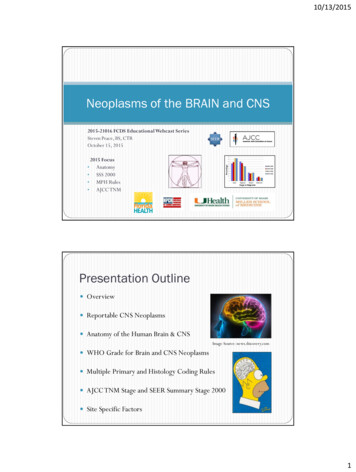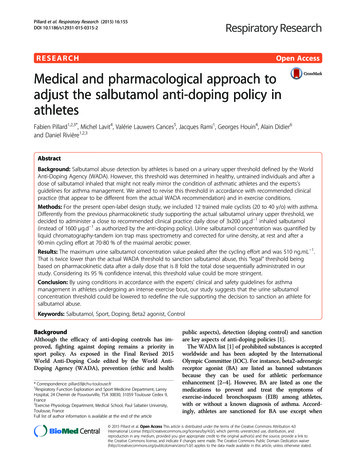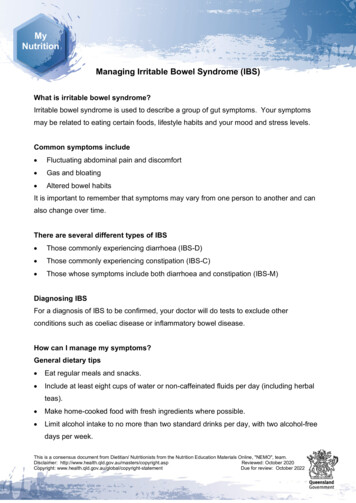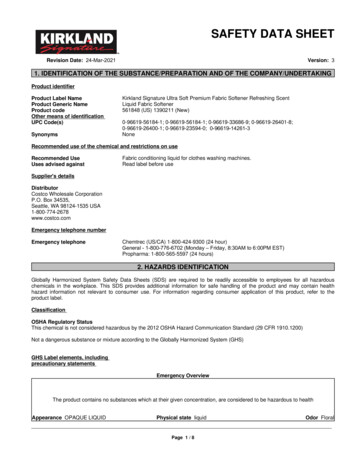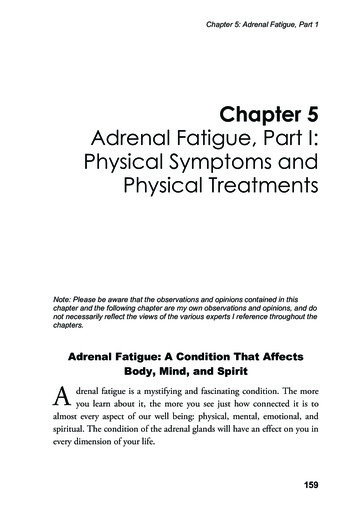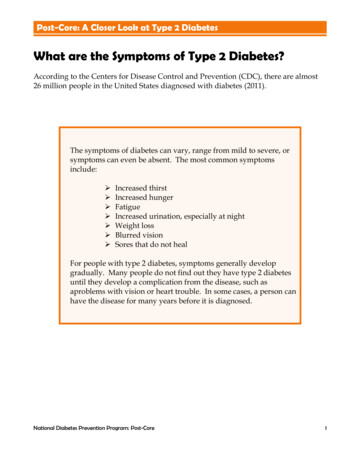
Transcription
Post-Core: A Closer Look at Type 2 DiabetesWhat are the Symptoms of Type 2 Diabetes?According to the Centers for Disease Control and Prevention (CDC), there are almost26 million people in the United States diagnosed with diabetes (2011).The symptoms of diabetes can vary, range from mild to severe, orsymptoms can even be absent. The most common symptomsinclude: Increased thirstIncreased hungerFatigueIncreased urination, especially at nightWeight lossBlurred visionSores that do not healFor people with type 2 diabetes, symptoms generally developgradually. Many people do not find out they have type 2 diabetesuntil they develop a complication from the disease, such asaproblems with vision or heart trouble. In some cases, a person canhave the disease for many years before it is diagnosed.National Diabetes Prevention Program: Post-Core1
Post-Core: A Closer Look at Type 2 DiabetesWhat is Diabetes?In order to describe diabetes, it is important to understand howthebody processes and uses food. Each time we eat food, our bodiesgo through a process that changes the food into energythat our bodies can use for daily activity.The food we eat is broken down by our bodies into “glucose.”Glucose is what fuels cells of the body; these cellsneed energy from glucoseto live. Glucose from thefood iscarriedby the blood to cells throughout thebody. Glucose, however, is not automaticallyabsorbed by cells.Insulinis required to “unlock” the cells and allow theglucose to be changed into energy.If there is not enough insulin or if the body does not use insulin properly,(a condition known as insulin resistance), then glucose is not able to get intothe cells. As a result, glucose builds up in the bloodstream (causing high bloodsugar).There is no cure for diabetes. Properly managing the disease requires lifestylechanges and medication. When diabetes is not controlled, glucose builds upin the blood and can cause damage to vital organs. When diabetes is controlled,complications can often be avoided.There are two types of diabetes. In type 1 diabetes a person’s body does not makeenough insulin to help move glucose into the cells for energy. In type 2 diabetes aperson’s body does not use insulin effectively and over time will not make enoughinsulin. Type 1 diabetes typically happens to people under the age of 30 andcannot be prevented. Type 2 diabetes can be prevented.National Diabetes Prevention Program: Post-Core2
Post-Core: A Closer Look at Type 2 DiabetesHow is Diabetes Diagnosed?Testing for diabetes and prediabetes should be done by a health care provider.There are currently three tests that can be done.Fasting plasma glucose (FPG)This test measures for impaired fasting glucose (IFG); a person’s blood glucoseis measured first thing in the morning following an eight-hour fast.Fasting blood glucose levels: Normal: below 100 mg/dl (milligrams per deciliter) Prediabetes: between 100 and 125 mg/dl Diabetes:126 mg/dl or aboveOral glucose tolerance test (OGTT)This test measures for impaired glucose tolerance (IGT). A person’s bloodglucose is measured after an eight-hour fast and again two hours after drinkinga glucose-rich solution.Levels measured two hours after drinking the solution: Normal: below 140 mg/dl Prediabetes: 140-199 mg/dl Diabetes: 200 mg/dl or aboveGlycated Hemoglobin (HbA1c)This blood test measures a person’s average glucose level over aeight to twelveweek period before the test is given. Blood is drawn from a person’s arm;fasting is not necessary.HbA1c levels: Normal: HbA1c below 5.7% Prediabetes: HbA1c 5.7 – 6.4% Diabetes: HbA1c 6.5% and aboveNational Diabetes Prevention Program: Post-Core3
Post-Core: A Closer Look at Type 2 DiabetesWhat Should My Medical Care be Like?If you are diagnosed with diabetes, you and your doctor will work out a diabetescareplan and build a team of health care providers to give you the care and informationthat you will need to safely and effectively manage the disease.PrimaryCarePhysicianYour first visit with your physician would include a physicalexamination, medical history, and blood and urine tests.Follow-up visits to your physician shouldhappenregularly.RegisteredDietitianIt would be important for you to meet with a registereddietitian who is trained in diabetes management. Thedietitian would teach you about how different foods affectyour blood glucose levels and get you started on a healthyeating plan (if you aren’t already maintaining thosepractices).DiabetesEducatorA diabetes educator is trained to help people with diabeteslearn to self-manage their disease. A diabetes educator canbe a nurse, dietitian, pharmacist, or other health careprovider. Your doctor would give you a referral for adiabetes education visit.SpecialistsDiabetes can cause problems with blood vessels and nerves.This can lead to problems with blood flow to the heart, eyes,kidneys, legs, and other organs.Your doctor would help youidentify what kind of specialists you need to see.YOUYou would be the most important person in managing yourdiabetes. Diabetes management and control starts withproper self-care. You should seek every resource to learn asmuch as you can about your diabetes. Knowledge is power!National Diabetes Prevention Program: Post-Core4
Post-Core: A Closer Look at Type 2 DiabetesHow Would My Life at Home Change?The cornerstone of diabetes care is managing your daily lifestyle. To reducecomplications related to diabetes, you would try to maintain proper blood glucose,blood pressure and lipid levels, take prescribed medications, and develop a nutritionand physical activity plan.BloodGlucoseLevelsYou would need to test your blood glucoselevels on a regular basis as determined byyour physician. Your doctor would give youa target range for your blood glucose levels,and tell you how often to test.PhysicalActivityIt is recommended that people with diabetesget at least 30 minutes of physical activityfive days a week. Physical activity helpsmaintain proper glucose levels, helps withweight loss or maintenance, and contributesto a healthy heart. You would talk with yourphysicianbefore starting your activity plan.MedicationsPeople with diabetes may need to takemedications and/or insulin to help controlblood glucose levels.National Diabetes Prevention Program: Post-Core5
Post-Core: A Closer Look at Type 2 DiabetesConditions and Complications Related to DiabetesThere are symptoms related to high and low blood glucose levels:Hyperglycemia (High Blood Glucose):Hyperglycemia is when your blood glucoselevels are too high and your body is not using its insulin properly. High bloodsugar levels can lead to the development of long-term complications.Hypoglycemia (Low Blood Glucose): Hypoglycemia is when blood glucose levelsfall below the normal range. Some of the symptoms of hypoglycemia includedizziness, headache, shaking, and irritability.There are long-term complications related to uncontrolled diabetes:Heart Disease and Stroke:Blood vessel problems are related to uncontrolleddiabetes. This can lead to heart disease and stroke. To lower the riskof complications from diabetes, remember the ABCS:A:A1c (a measure of blood glucose level)B: Blood pressureC:CholesterolS: Smoking Cessation (if you smoke)Kidney Disease:Blood vessel problems can also lead tokidney disease.Problems arisewhen the kidneys have to work extra hard to filter the excessglucose in the blood. Over time, this damage can lead to kidney failure, which isa serious and life threatening problem.Foot Complications:Blood vessel problems can affect blood flow to the feetand legs, and nerve problems can affect sensation in the feet. Good bloodglucose control and proper foot care can prevent problems leading to ulcers,circulation and nerve problems, and amputation.Eye Complications:People with diabetes are at a higher risk of developingretinal/eye problems. Complications include glaucoma (damage to the opticnerve), cataracts (cloudy area in the lens), and retinopathy (general termfor disorders of the retina).National Diabetes Prevention Program: Post-Core6
When diabetes is not controlled, glucose builds up in the blood and can cause damage to vital organs. When diabetes . is . controlled, complications can often be avoided. There are two types of diabetes. In . type 1. diabetes a person's body does not make enough insulin to help move glucose into the cells for energy. In . type 2. diabetes a






